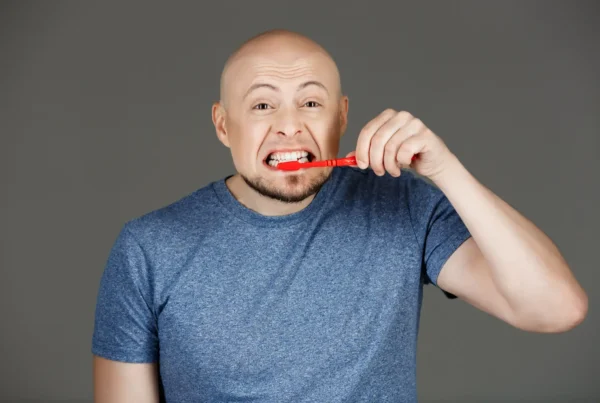- What is a sonic toothbrush?
- How does a sonic toothbrush work?
- Sonic or electric toothbrush – which one is better?
- How many strokes do toothbrushes generate?
- How does brushing speed affect cleaning performance?
- How to brush your teeth with a sonic toothbrush?
- How to choose the best sonic toothbrush for your needs?
- Why choose a sonic toothbrush?
- Can everyone use a sonic toothbrush?
- Which toothpaste should you use with a sonic toothbrush?
- What makes sonic toothbrushes for kids special?
Oral hygiene simply wouldn’t be possible without a toothbrush. When choosing the right toothbrush, it’s important to remember that the type we select can significantly affect the quality of our brushing, and therefore, the health of our teeth and gums. So which one should you choose? A manual, electric, or perhaps a sonic toothbrush? The latter has been gaining increasing popularity among users recently. What makes sonic toothbrushes effective and what should you consider before purchasing one? Stay with us to discover what a sonic toothbrush is, how it works, its benefits, and much more.
What is a sonic toothbrush?
At first glance, a sonic toothbrush looks similar to an electric one. It features a built-in rechargeable battery, a control panel with one or more buttons, and a detachable brush head.
However, the first noticeable difference between a sonic and an electric toothbrush is the shape of the brush head. The sonic version has an elongated head rather than a round one. This is a major advantage, as the shape allows better access to hard-to-reach areas, including the back molars.
Sonic toothbrushes are sometimes referred to as “sound wave toothbrushes” because they emit sound waves at a frequency of around 260 Hz. These waves generate sweeping motions of the bristles at a very high rate—up to 96,000 vibrations per minute in the most advanced models. This impressive speed, combined with the elongated brush head, sets sonic toothbrushes apart from other oral hygiene devices.
How does a sonic toothbrush work?
As you’ve already learned, sonic toothbrushes work by producing sound waves that move the bristles in a sweeping motion. The exact frequency depends on the specific model but can reach speeds as high as 96,000 strokes per minute, as seen in models like Smilesonic EX and Smilesonic UP.
Thanks to this high-speed action, a phenomenon known as cavitation occurs inside the mouth during brushing. This effect enables the toothbrush to remove buildup from even the most hard-to-reach areas. The rapid movement of the brush mixes saliva, water, and toothpaste, creating millions of microbubbles. These bubbles reach into every crevice in the mouth, removing bacteria and debris effectively.
Sonic or electric toothbrush – which one is better?
Anyone looking to switch from a manual toothbrush to something more advanced will likely face the classic dilemma: sonic or electric? To answer this, let’s compare both types of toothbrushes based on their operation, speed, and brush head design.
Electric toothbrushes feature round brush heads, inspired by professional dental tools. This shape adapts well to the contour of each tooth, allowing thorough cleaning from every angle. Sonic toothbrushes, in contrast, have elongated brush heads similar to those found on manual toothbrushes. These heads are excellent at reaching difficult areas, and some experts believe they can even replace flossing in certain cases.
Brush heads on electric toothbrushes are designed for rotational movements, whereas sonic toothbrushes use sweeping motions recommended by dentists for being the most effective and safe.
READ MORE: Why is a sonic toothbrush better than an electric one?
How many strokes do toothbrushes generate?
A manual toothbrush can produce about 200 strokes per minute. This serves to highlight the massive performance gap between standard brushes and their battery-powered counterparts.
Electric toothbrushes generate oscillating-rotating movements, and higher-end models also include pulsating motions. They can perform around 8,800 oscillations and 40,000 pulsations per minute. Impressive, yes—but sonic toothbrushes go even further. On average, they deliver 62,000 sonic vibrations per minute, with some models capable of up to 96,000 strokes when set to whitening mode. That’s a remarkable difference.
How does brushing speed affect cleaning performance?
Proper oral care protects against tartar buildup, inflammation, and cavities. Accuracy is key in brushing, and the more strokes a toothbrush can generate, the more thorough the cleaning. Fast-moving bristles can also brighten enamel and restore natural whiteness to your teeth.
While speed is crucial, the correct brushing technique is just as important. This is another area where sonic toothbrushes shine. You simply place the brush at a 45-degree angle to the gum line, and the brush does the work for you—no additional movements required. Electric toothbrushes, however, are best used with the “bucket method,” which involves brushing each tooth individually, requiring more skill and practice.
How to brush your teeth with a sonic toothbrush?
Brushing your teeth with a sonic toothbrush is easy, but it’s still essential to follow a few care guidelines to ensure safe and effective cleaning.
To start, apply toothpaste to the brush head. Then hold the toothbrush at a 45-degree angle to your teeth so that the bristles point toward the gum line. Turn on the device and slowly guide it along each section of your dental arch. Be sure to clean the outer, inner, and chewing surfaces of your teeth. Avoid applying too much pressure, as this could irritate the enamel.
Most modern sonic toothbrushes come with two built-in timers. The first is a general timer that ensures you brush for the dentist-recommended two minutes. The second, called a quadpacer, alerts you every thirty seconds to switch to a different quadrant of the mouth.
How to choose the best sonic toothbrush for your needs?
Selecting the right sonic toothbrush can be challenging, but answering a few basic questions can help you narrow it down. Consider whether you’re dealing with tooth sensitivity, gum inflammation, or excessive plaque buildup. If you frequently drink coffee or tea, think about whether these beverages are causing stains on your enamel. These factors will guide you in choosing the most suitable device.
Sonic toothbrushes differ in speed, available brushing modes, and battery life. Each of these parameters should be taken into account.
Higher brushing speed improves the toothbrush’s ability to remove daily deposits. The more sweeping strokes per minute, the better the toothbrush handles plaque and stains. If you drink a lot of coffee or tea, models offering 80,000 to 96,000 sonic vibrations per minute, like those from Smilesonic, are ideal. If you have sensitive teeth and gums, gentler modes producing around 60,000 vibrations per minute may be more appropriate.
Premium sonic toothbrushes offer multiple brushing modes that can be tailored to your needs. These include whitening, gentle, and gum massage modes that improve circulation and gum health. A model with multiple modes is especially useful if the toothbrush will be shared with family members or if your dental needs change over time.
Battery capacity is another key factor. Most sonic toothbrushes can last 2–3 weeks on a single charge when used twice a day for two minutes. Some models, like those from Smilesonic, can last up to two months, making them perfect for frequent travelers or shared usage.
Why choose a sonic toothbrush?
Many users wonder why they should invest in a sonic toothbrush when a manual one also gets the job done and is far more affordable. There are several reasons.
First, sonic brushing is significantly easier. A manual toothbrush is only effective when used with the correct technique, which many people struggle with. Second, sonic toothbrushes time your brushing for you, eliminating the risk of cutting your session short. Third, their high speed is essential for removing plaque and deposits. After just a few weeks of sonic brushing, you’ll notice visibly whiter and healthier teeth.
Benefits of using a sonic toothbrush include noticeable whitening of enamel within weeks, effective removal of stains from coffee, tea, or tobacco, reduced plaque buildup, prevention of tartar formation, improved gum circulation and health, protection against cavities, gum recession, and exposed roots, thorough cleaning even in hard-to-reach areas, and fresher breath.
Can everyone use a sonic toothbrush?
Yes. There are virtually no contraindications for using a sonic toothbrush, even for individuals with oral health issues. These devices are especially recommended for people with braces. Thanks to orthodontic brush heads, they can clean difficult areas around braces, which are prone to plaque and cavities.
Sonic toothbrushes are also suitable for people with gum disease or sensitivity. The gentle brushing modes are perfect for these conditions. Those who consume a lot of coffee, tea, or red wine will also benefit from the whitening modes that effectively remove stains.
Which toothpaste should you use with a sonic toothbrush?
Do you need to change your toothpaste when switching to a sonic toothbrush? Ideally, yes. Toothpastes designed for sonic brushing usually have a thicker texture and are free from SLS, reducing foaming and making them easier to use. However, standard toothpaste can also be used, provided it has a low abrasion level to avoid irritating the enamel.
What makes sonic toothbrushes for kids special?
Sonic toothbrushes are also available for children, including those under the age of three. These brushes produce gentle vibrations—usually around 16,000 per minute—making them safe and comfortable for young users. They also feature smaller brush heads and fun elements like bright colors or music, making brushing more enjoyable.
We recommend the Smilesonic Kids model to all parents. A sonic toothbrush helps children get used to powered brushing and protects them against cavities and other oral diseases as their permanent teeth begin to emerge.






